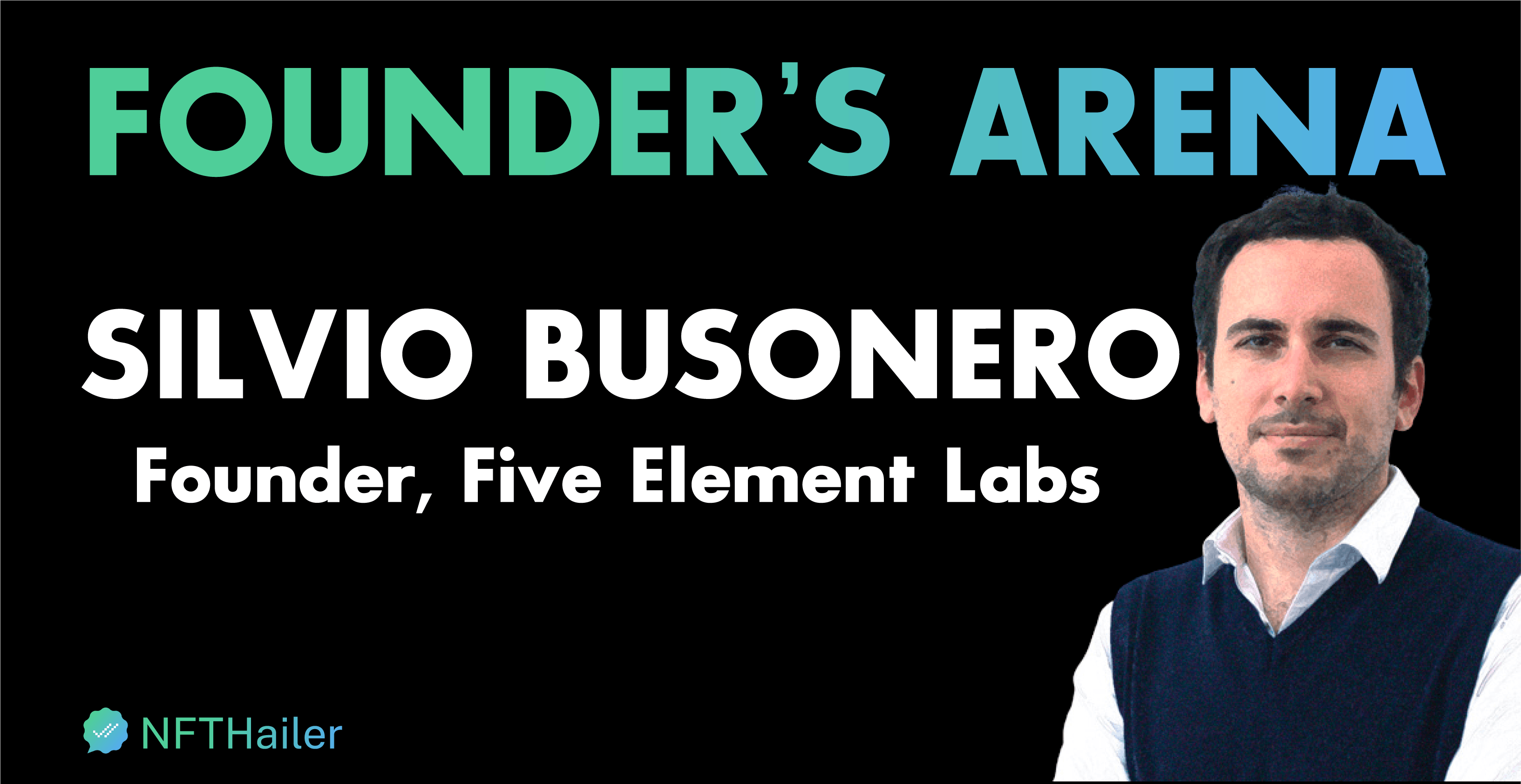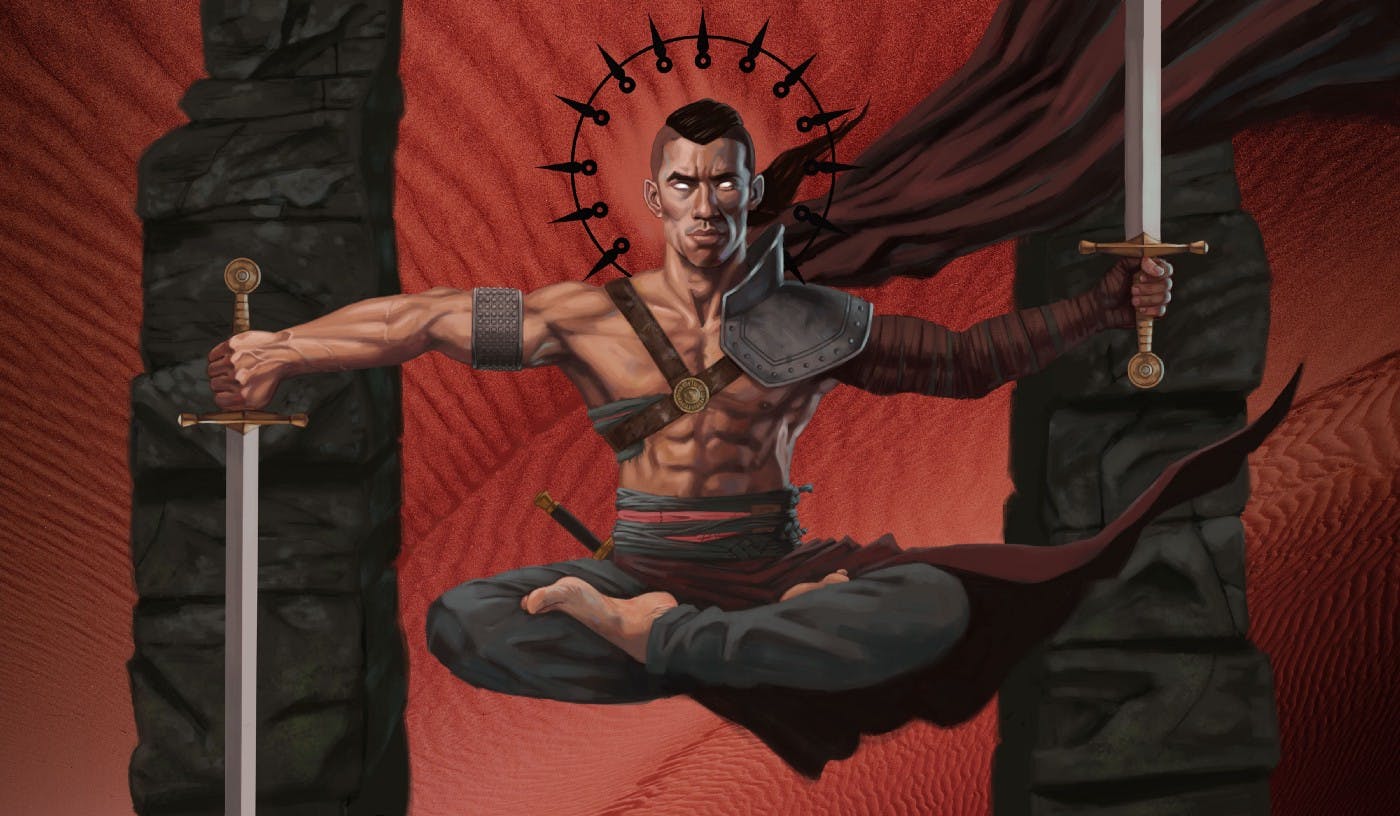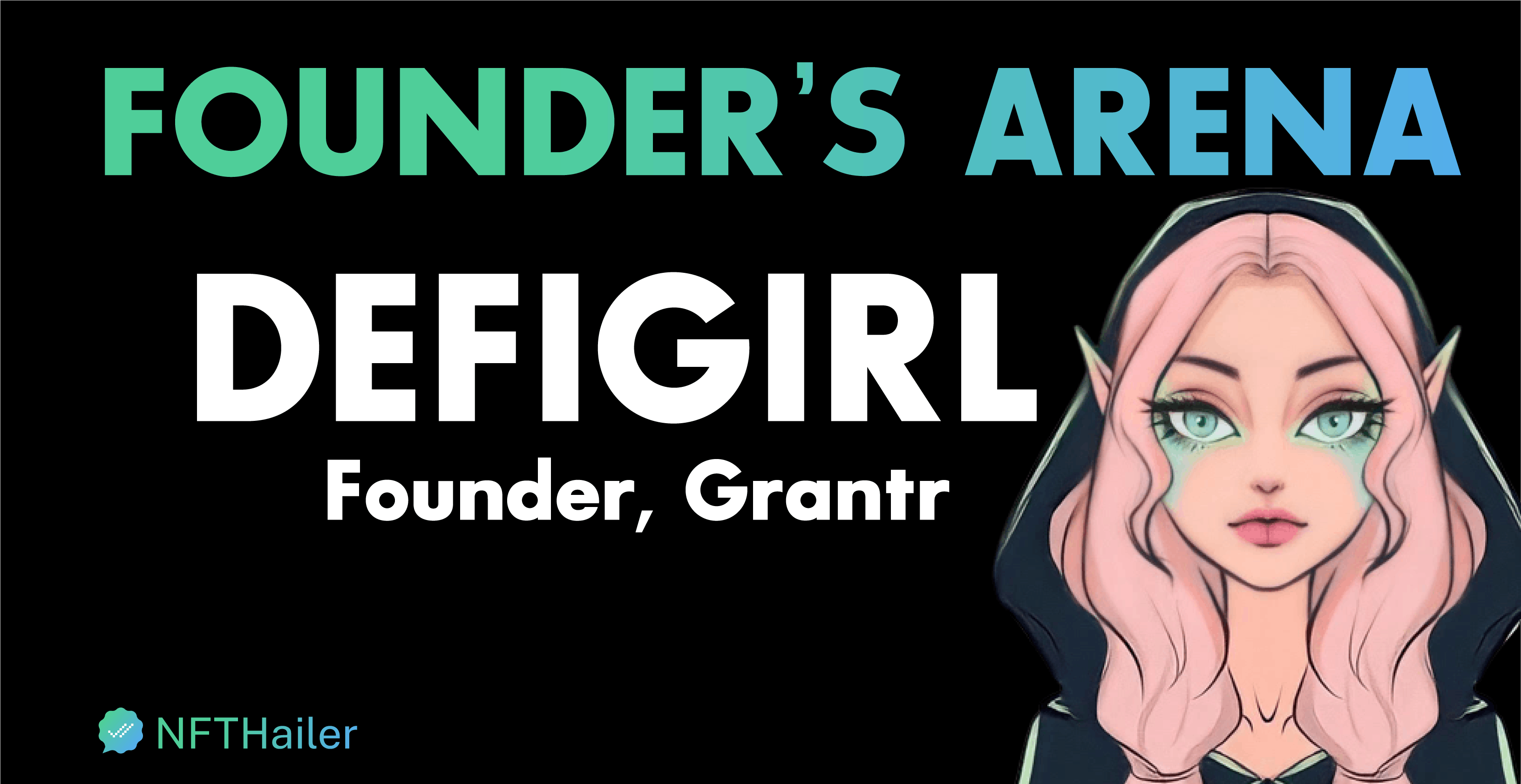Founder's Arena with Silvio Busonero, Founder of Five Element Labs

In this interview, Girri and Justin speaks with Silvio Busonero, founder of Five Element Labs.
This interview has been edited for conciseness and clarity.
Girri: Could you tell us about your background?
Silvio: I have a background in statistics and mathematics. I also studied economics and I have a past in consulting. For several years, I worked at Oliver Wyman. My job was to develop statistical models for banks, like the central bank in Europe, for risk management purposes. I have mostly worked in Europe but I also worked in Asia for almost a year.
Then I finally jumped into the crypto RabbitHole in August of 2020 and began to dig deeper. In January 2021, I went full time into crypto. Fast forward to July 2022, I started a software house called Five Element Labs in Italy. The idea is to form a group of people that are very strong technically and to compete globally in the market by shipping several kinds of products out faster. One of the products that we're working on, which is the topic of the discussion, is TIDE protocol, which is a way to bring NFT marketing to Web3.
Girri: So you said that you started out with DeFi and then now you're shifting gears to focus on NFT marketing. What was that evolution like? How did you arrive at this idea?
Silvio: As a team, the idea was to skill ourselves and to educate the younger guys on new developments. We participate in avatars and have won several, including Lens protocol, a protocol for social media. Then we started thinking, if social media in Web3 is going to be huge, there will also be new ways for creators and promoters to engage with communities and air their content. We started to build the prototype for that version on top of layers, which was like a pay-per-click prototype. If someone wants to see this, you have to create a Google ad on this. But then I realized that it was not really Web3 - it was really a Web2 model.
We brought two products after looking at the market. We saw that the NFT market is far behind DeFi in terms of infrastructure. There are in fact several operations that can be brought on-chain. That's our idea. As a matter of fact, also that's more or less been the assumption behind the Lens protocol. We talked to a lot of NFT projects, which we saw from the very early days. These were pre-Twitter or pre website pre-launch, apps to be launched and whether they're supposed to launch - they engage in a series of lotteries of games with the community, whether they do this on Discord or Twitter or whatever. Project Five Labs saw that these games have diminishing returns.
I'd like to clarify that these games are giveaways. Basically, some prizes are given to communities for certain actions on social media, so it's not fair, transparent or automated. There are a lot of bots, for example. Moreover, speaking with projects, there is a challenge in that they cannot target these kinds of incentives. Our solution is to build something that they can use to target people on-chain based on their wallet activity. We are building this right now and it should be ready for announcement by the end of month. The business tracking part basically has a soulbound token with information about your NFT history. This information includes transaction volume metrics and labels. So you can deploy a smart contract with arbitrary rewards, ratios, so on and so forth, targeted to a specific community.
Girri: Is the principal benefit for an NFT community that they are able to do more effectively? Is it about ensuring fairness? What would you say is the principal benefit for an NFT project to use the TIDE protocol?
Silvio: Targeting is the most important thing. On their end, they can still run campaigns on Twitter, even if it's not fair - the community doesn't always care. Butthe NFT crowd is very different from the DeFi crowd. For example, let’s say I'm launching an anime cosplay project in Singapore. Which wallets should be targeted for this community? What are the ways I can ensure that people interact with me with campaigns that are organic? This kind of question depends on the nuances of OpenSea volumes or balance.
Justin: I find it very exciting that you can essentially target certain user preferences that you aren't able to do in Web2. Could you give me an example of how that might differ from targeting on social media platforms currently? Let’s say a marketing company goes to Facebook or Twitter as opposed to TIDE, a tool based off of Lens protocol.
Silvio: The main difference is that you're going to target on-chain data. The tool is related to X, Y and Z communities. We look at past orders and related projects of these communities in their defined clusters. We can identify community members that are real, and possibly also those in the top 5% or 1%. The idea is that you try to go to a higher quality target with probable activities in similar markets. For instance, there are several classifications that you can do for wallets that are involved in women led projects. Some of them are more scalable, some of them are less scalable. In the approach we use now, we basically design the whole thing - including the target and then we build the smart contract specifically for them. But we'd also like to roll out a scalable solution, when we have 20 or 30 campaigns under our belt.
Justin:
One challenge that comes to mind is a lot of targeting or micro clustering happens around demographic traits - like gender, geolocation, or a behavioral trait. For a lot of folks in NFT or Web3 who want to remain anonymous or who want to keep some of those demographic traits invisible, how do you overcome that? I'm curious from a conceptual and a technical perspective.
Silvio: So far, we don't wish to tackle these kinds of data. One of the reasons is that, as you mentioned, it's not really Web3 friendly. However, in the future, I find the concept of being paid for my own data very powerful. The idea is that we start by making sense of public data and tracking it. We will not use something that is not public. You're still getting paid for the public data, though. If you are eligible for campaigns, you get notified. However, I think this idea of paying for personal data is an important topic.
Girri: When it comes to marketing, in which stage of the lifecycle are projects most interested? I'm assuming most projects are interested in marketing mostly premint, but is there also an interest in marketing postmint as well? How does it shift through the lifecycle of the project?
Silvio: Great question. Projects we are working with now are pre-launch, very early pre-launch - three or four months away from launch, which is great for us, because we can really follow the entire process. I think that one advantage of this tool, with respect to others in the market, is that you really have a lot of degrees of freedom when designing campaigns. For instance, after launch, you can design loyalty programs on-chain for early collectors and do other stuff, but so far, it's more prelaunch. Obviously, we want to stay in the whole life cycle. We see opportunities but early adopters are willing to test it in the prelaunch phase.
Justin: Are there particular NFT collections or groups that have a particular interest in using your protocol at this stage? What's been a successful use case of the Lens protocol?
Silvio: We started testing with our products, roping the community in. With our DeFi product, we did a semi-normal campaign on Lens and Twitter incentivizing people to retweet and share. That received a lot of attention. It’s a normative use case on our first incentivized web repost. We repeated the experiment with the TIDE protocol, formerly called Lens Booster. We got more than a thousand applications to beta test our application.
We like how the experiment is going so far. It taught us that on the user side, people are prone to engage with content they like - and be paid to do so. The idea is that we also cover the kind of users that are not super influencers, but they stand by your brand and they can be legitimately incentivized. More campaigns will appear on Lens protocol, but also on Twitter, because talking with people is the best method out there. There will be a sort of hybrid Web3. However, for now, it’s talking with users, that's important.
Girri: This whole bridge between Web2 to Web3 is super fascinating. Could you kind of explain to us how you measure off-chain data on Twitter and link it with an on-chain marketing program?
Silvio: Right now, you need to use Project Galaxy or Ceramic Network, for identities tied to wallets. As a matter of fact, we are using Ceramic for the first project. Once you connect the wallet to Twitter, you can type in on-chain data and off-chain data. The Twitter API is enough to collect off-chain data. Then we basically have our keepers - bots that send periodic signals to the smart contract.
Girri: Could you give a very high level explanation about what Ceramic is?
Silvio: Ceramic is a way to save, collect and manage data efficiently on-chain. So you can take it as a data layer on top of later ones. There is also the ceramic ID, which is powerful, and has been used in several applications. This seems to be part of a merging of different projects, like a pure Web3 stack, which will power applications of the future.
Justin: Tell us a bit more about the token mechanism - how do you design that reward system? This is something I think is quite novel and that there's some sort of reward based on your social graph, quite different from other forms of reward mechanism.
Silvio: The idea is that we have these campaigns, with smart contracts with incentives in the form of NFTs or ERC20 tokens. According to the stage of your campaign and the kind of campaign you want to do, you can choose different mechanisms for the rewards. That's something that we still do alongside projects. So for instance, if you want to find top community members, you can do a very restricted campaign with high prices. If you can use ERC20 tokens here, it's not something that you can do on Twitter, and it's not done anywhere else.
Justin: I think that really upends the normal way in which someone runs a campaign, say through Instagram influencers, where it's just sort of like a bait against top influencers. Now you have a more democratic structure involving those who are more loyal with your campaign.
Silvio: The idea is that you don't pay influencers. You go directly to your target. Another inefficiency that we noticed is that in the NFT market, people spend a lot of money on marketing. Things such as searching for lookalikes, and the prices are not tied to any metric whatsoever. It's tedious and not tied to real outcomes. Here, we try to offer measurable results.
Girri: To sort of synthesize, I guess, in a way you're making influencer marketing more precise and frictionless. Would that be a fair kind of synthesis of the project?
Silvio: Yes, correct.
Girri: You talked about how marketing just takes up so much time and energy for so many of these projects. I think for SaaS companies, close to 50% of the revenue is spent on marketing. Do you know what's the same figure for NFT projects - like what proportion of their premint of the mint revenue do they allocate for marketing right now?
Silvio: Most quality projects spend less on marketing. Usually, we identify a range between 20% to 50%, which I think is a lot. I think it's going to go down as fees go down but I also think it's going to be spent in a more sustainable way to get organic members and communities.
Girri: If you were to give advice to an NFT project, what are the three things that they can do to better market their project, given the kind of more challenging market circumstances that we're in right now. What would your advice be?
Silvio: I would say finding a compelling story for your project that goes from day 0 to post launch. Take a really long term view, with marketing carefully planned before. Also focus on a utility path for the product. Focusing on organic, focusing on utility, focusing on having NFTs as means to achieve a bigger mission for a bigger brand is really, really important. To summarize, focus on organic long term growth and avoid shortcuts.
Justin: Right now there seems to be a formulaic way in which NFTs are marketed. They find a specific demographic, and go to Twitter and Discord. How do you see marketing evolving beyond just better targeting? Are there any other channels or means through which they can outpace other competitors?
Silvio: I think what we are trying to do with our tech approach is trying to find creative ways to bring traffic. I think any project should try to make marketing nonconventional. The playbook has diminishing returns now. People are also not very keen to spend money on a JPEG. You need new approaches like a web budget tool to reward communities or whether it's to build a narrative around your project.
Girri: At the moment, what is your biggest unmet data need?
Silvio: We really would like to label projects. The service I would like to offer to my users is that there is a project and sometimes they don't know how to think about those targets. What I would like to do is classify projects according to some metrics that make sense, and to some category that makes sense.
Girri: What kinds of labels are you thinking of?
Silvio: One example is gaming. Others are anime and manga, racing cars - really it comes down to interests. Just meaningful categories.
Girri: This has been a blast. This is an ambitious project that is working on a important idea: programmable marketing. The idea of making marketing more transparent and fairer is key to Web3, and you have done a good job explaining it to us. My last question to you is if there are NFT projects out there listening to this and they want to use Tide protocol, what's the best way that they connect with you?
Silvio: My Twitter is Silvio: Busonero. You could also check out the Five Elements Labs on Twitter. And so far, TIDE protocol is a rebranding of Lens Booster. We just have to change the name because we are not just limited to Lens, so for now follow the Lens Booster Twitter page. You can check also check out other social channels.




